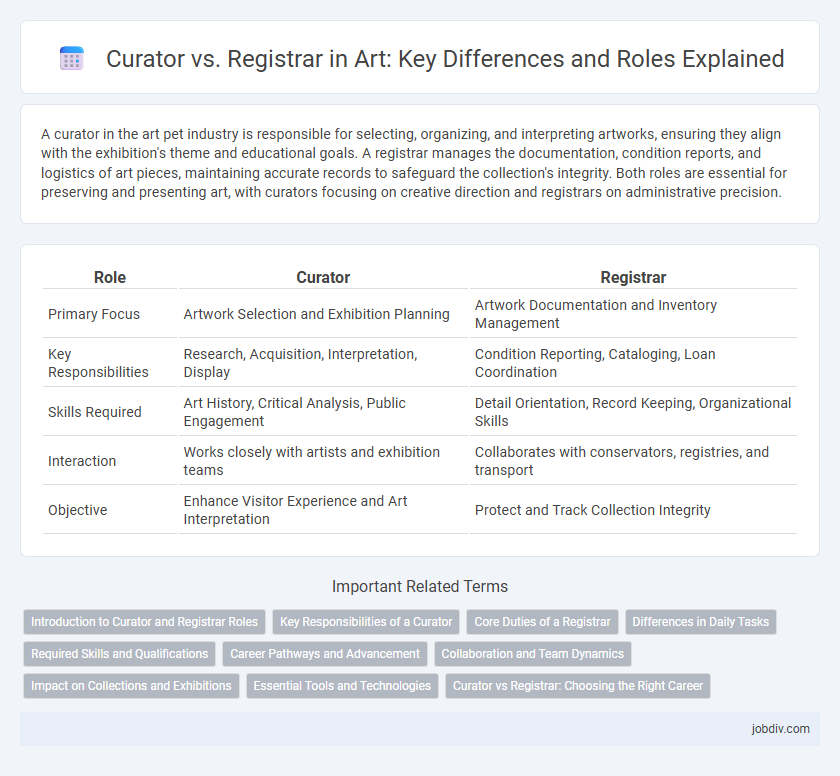A curator in the art pet industry is responsible for selecting, organizing, and interpreting artworks, ensuring they align with the exhibition's theme and educational goals. A registrar manages the documentation, condition reports, and logistics of art pieces, maintaining accurate records to safeguard the collection's integrity. Both roles are essential for preserving and presenting art, with curators focusing on creative direction and registrars on administrative precision.
Table of Comparison
| Role | Curator | Registrar |
|---|---|---|
| Primary Focus | Artwork Selection and Exhibition Planning | Artwork Documentation and Inventory Management |
| Key Responsibilities | Research, Acquisition, Interpretation, Display | Condition Reporting, Cataloging, Loan Coordination |
| Skills Required | Art History, Critical Analysis, Public Engagement | Detail Orientation, Record Keeping, Organizational Skills |
| Interaction | Works closely with artists and exhibition teams | Collaborates with conservators, registries, and transport |
| Objective | Enhance Visitor Experience and Art Interpretation | Protect and Track Collection Integrity |
Introduction to Curator and Registrar Roles
Curators oversee the conceptual development, acquisition, and interpretation of art collections, ensuring exhibitions align with institutional missions and engage diverse audiences. Registrars manage the documentation, care, and logistics of collections, maintaining detailed records and coordinating transportation, storage, and condition reports. Both roles are essential for preserving artistic integrity and facilitating public access to art.
Key Responsibilities of a Curator
Curators oversee the acquisition, research, and interpretation of art collections, ensuring exhibitions accurately convey artistic themes and historical context. They collaborate with artists, scholars, and other cultural professionals to develop engaging gallery displays and educational programs. Curators also manage collection care strategies, including provenance documentation and conservation priorities to maintain institutional integrity.
Core Duties of a Registrar
The core duties of a registrar in the art world include maintaining accurate and detailed records of all artworks in a collection, overseeing the logistics of acquisitions, loans, and exhibitions, and ensuring proper handling, storage, and conservation of artworks. Registrars coordinate between curators, conservators, and external institutions to facilitate smooth operations and compliance with legal and insurance requirements. Their role is essential for protecting the integrity and provenance of each piece, enabling efficient collection management and access.
Differences in Daily Tasks
Curators focus on researching, organizing exhibitions, and developing educational programs to engage the public with art collections. Registrars handle the documentation, condition reporting, and logistics of artwork, ensuring proper care and legal compliance during acquisitions and loans. While curators prioritize interpretive content and visitor experience, registrars manage the operational and administrative aspects of collection management.
Required Skills and Qualifications
Curators require expertise in art history, research, and exhibition design, often holding advanced degrees such as a Master's or PhD in Art History or Museum Studies. Registrars must have strong organizational skills, attention to detail, and proficiency in collections management systems to handle inventory, documentation, and condition reporting accurately. Both roles demand knowledge of conservation principles and familiarity with legal and ethical standards in art handling and acquisitions.
Career Pathways and Advancement
Curators typically advance through roles involving research, exhibition planning, and collection development, often requiring advanced degrees in art history or related fields. Registrars focus on art object management, including acquisition, documentation, and conservation, with career growth emphasizing expertise in collection logistics and legal compliance. Both pathways offer progression into senior museum management, with curators leaning towards academic leadership and registrars specializing in collection stewardship.
Collaboration and Team Dynamics
Curators and registrars collaborate closely to ensure the integrity and successful management of art collections, blending curatorial vision with meticulous documentation and care. Effective team dynamics arise when curators provide exhibition concepts and interpretive frameworks while registrars handle logistics, condition reporting, and provenance research. This partnership enhances collection stewardship, supports informed decision-making, and facilitates seamless exhibition execution.
Impact on Collections and Exhibitions
Curators shape the narrative and vision of collections by selecting artworks that align with thematic goals, directly influencing exhibition content and audience engagement. Registrars ensure the preservation and accurate documentation of artworks, managing logistics that protect collections from damage and loss. Their collaboration guarantees both the conceptual integrity and physical safety of exhibitions, enhancing the overall museum experience.
Essential Tools and Technologies
Curators utilize collection management software and digital cataloging tools to organize and interpret artworks, enhancing exhibition planning and scholarly research. Registrars rely on inventory control systems, condition reporting applications, and secure database technologies to track provenance, acquisitions, and ensure the safety and insurance compliance of art objects. Both roles integrate RFID tagging and environmental monitoring devices to maintain optimal preservation conditions within museums and galleries.
Curator vs Registrar: Choosing the Right Career
Curators shape the artistic vision and narrative of museums by managing, researching, and exhibiting collections, while registrars specialize in the precise documentation, preservation, and logistical handling of artworks. Career success as a curator demands strong expertise in art history, public engagement, and exhibition development, whereas registrars require meticulous attention to detail, organizational skills, and knowledge of conservation protocols. Choosing between curator vs registrar roles depends on whether one prefers creative storytelling and public interaction or focused management and technical care within the art world.
Curator vs Registrar Infographic

 jobdiv.com
jobdiv.com